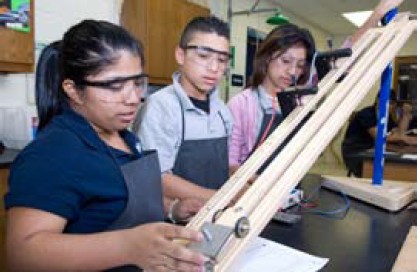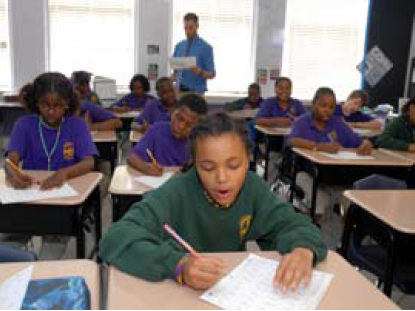
Progressive Reforms
Early reformers tried to establish consistent academic standards, train teachers, or consolidate schools in the name of efficiency. In other words, to transform education into a profession.
These efforts culminated in the Progressive Movement of the late 19th and early 20th centuries, when educators like John Dewey called for fundamental reform in what schools taught and how they operated. Dewey and his supporters urged giving teachers greater independence in the classroom, emphasizing learning by doing instead of rote memorization and challenging students to think independently.
But Dewey’s “child-centered” approach was almost immediately challenged by those more interested in using new social science methods to increase efficiency and organize students into separate tracks of those destined for college or for manual labor. Progressive education was also widely misunderstood, as its emphasis on the needs of children became interpreted as a lack of academic standards.

Working on a high school physics experiment in Hidalgo, Texas.
Nation at Risk
Criticism of new or progressive ways of teaching resurfaced in the 1950s, when the debate over the most effective ways to teach language skills to children triggered stories on “Why Johnny
Can’t Read.” (A similar debate, two decades later, inevitably produced “Why Johnny Can’t Write.”)
The 1957 launch of the Soviet satellite Sputnik triggered similar concerns and led to an increased emphasis on science and mathematics in an era of Cold War conflict and the U.S.-Soviet space race.
In 1983, a highly influential report called A Nation at Risk asserted that declining academic standards threatened America’s position in an increasingly competitive world and called for more resources and greater rigor in education.
The response to the Risk report ranged from lengthening the school day and year to greater emphasis on core academic subjects. Yet the report’s conclusions have been vigorously disputed. “Not only is it not true there has been a great decline,” contends historian Carl Kaestle in the book School, “but it is also true that we are educating a much wider proportion of our population now than we were in the 1950s.”

Using microscopes to observe bacteria in pond water in a high school science lab, Donna, Texas.
Charter Schools and Competition
Many recent school reforms have sought to introduce greater competition into the public school system. Charter schools, for example, are independently operated public schools that must meet the same academic and legal requirements as traditional public schools but are free from most of the bureaucratic and regulatory constraints of their traditional counterparts. Approximately 2,000 charter schools are now operating in the United States.
Another response to concerns over academic standards and international competition has been to forge alliances between business and schools. In some cases, school districts have tried to emulate efficiencies and organization of the corporate model by establishing standards and goals that can be measured and by holding administrators and teachers accountable for results.
In the push for accountability, many states have passed laws permitting the closure of low-performing or failing public schools. In such cases, which are still rare, the schools can choose to reconstitute themselves with new staff and teachers or convert themselves to charter-school status. Families with failing neighborhood schools are often given the opportunity to transfer their children to higher-performing schools.
School vouchers have proven to be a highly controversial innovation. A voucher program permits parents to leave failing or substandard public schools and receive public funds to cover all or part of the tuition at private schools. The amount is usually based on the per-student spending in the community. The idea is that if schools have to compete for students, they will improve. However, the controversy over using tax money to support private or religious schools has been intense, and few communities have fully implemented school vouchers.

Learning multiplication tables at a charter school in New Orleans, Louisiana.
Privatization
Estimates are that private, for-profit companies now operate 10 percent of the nation’s public charter schools. One of the largest is Edison Schools, founded in 1992, which runs charter schools in 19 states and the District of Columbia, as well as providing “academic academies” and other services in partnership with existing public schools.
Traditional organizations of public school professionals like the National Education Association oppose privatization, contending that there is an inherent conflict between the profit demands of private companies and the needs of schoolchildren. Companies like Edison contend that competition can help improve both public and privatized schools, thereby benefiting the “customers” — students — just as in any other marketplace.
Both sides point to outside studies that buttress their side of the argument. Public school proponents cite reports in the 1990s that show there is no substantial edge for Edison students or that Edison schools publicize only favorable results. A RAND Corporation study in 2000, on the other hand, concluded that “student achievement gains at Edison Schools matched or exceeded similar improvements in student performance in comparable public schools.”
High School Redesign
Another reform movement, led by the Bill and Melinda Gates Foundation, has taken a very different approach to educational reform through a fundamental rethinking of high schools themselves. “Our high schools were designed 50 years ago to meet the needs of another age,” says Bill Gates, founder of Microsoft.
Over the past five years, the foundation has funded high performing model schools that “engage all students with a rigorous curriculum. They offer coursework that is relevant to students’ lives and aspirations. And they foster strong relationships between students and adults.”
The Gates redesign effort also stresses that smaller is usually better. “All else being equal,” says a foundation report, “students in small high schools score higher on tests, pass more courses, and go on to college more frequently than those in large ones. Moreover, these results appear to be greatest for low-income students and students of color.”
No Child Left Behind

Second-grade charter school students in Bensalem, Pennsylvania.
The most sweeping change to the federal role in education since the 1965 Elementary and Secondary School Act is the Bush administration’s 2001 No Child Left Behind (NCLB) law. NCLB requires states to set educational standards for achievement at different grade levels and to take steps to improve the performance of those who don’t meet the standards.
NCLB mandates state goals for what children should know in reading and mathematics in grades three through eight as measured on standardized tests. These and other accountability measures of school performance are then collected into statewide annual report cards.
Although state and local school systems have considerable flexibility in upgrading performance levels, the law provides for eventual removal of students and funding from failing schools. Parents with children in failing schools can transfer to other public schools or charter schools. They also are eligible for tutoring and other special services.
NCLB has generated responses ranging from strong support to skepticism to outright opposition, according to a 2004 report by the Education Commission of the States.
Supporters believe that the nationwide institution of standards, testing, and accountability are essential to building and maintaining high-quality schools that can succeed in an intensely competitive global economy.
Other groups, such as the American Federation of Teachers and the National Education Association, have raised strong concerns about how the law distinguishes between effective and ineffective schools when student populations differ so much in background, income, and English language ability. Parents point to schools sacrificing art classes or other enrichment activities to “teach to the test” and avoid any designation as a failing school.
Jason Kamras, 2005 National Teacher of the Year, says, “No Child Left Behind’s greatest strength is that it has institutionalized high expectations for every child in America.”
From a longer viewpoint, NCLB is only the latest installment in the long debate over balancing the demands of inclusion and excellence in American education.

Smiling Toyota scholarship winner in San Marcos, Texas.



















